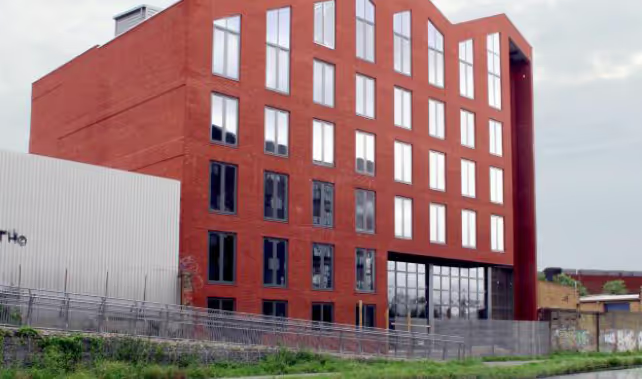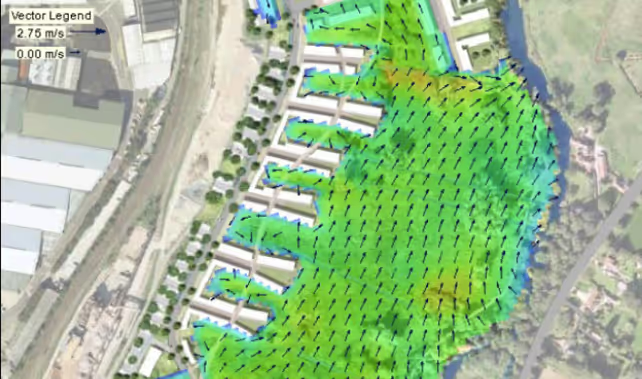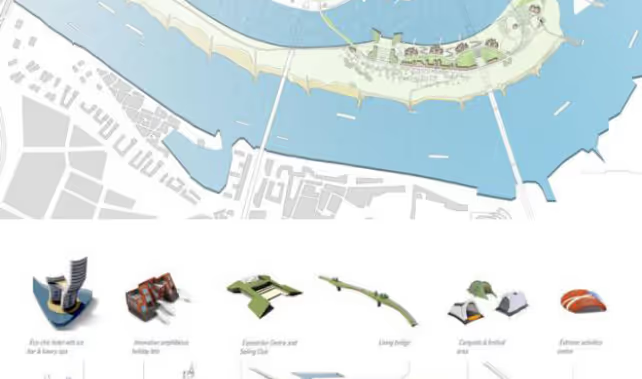

White Post Quay in Hackney Wick, opposite the Olympic Park, has become home to swimwear specialist Speedo for the duration of the Olympic and Paralympic Games.
With the stimulus of the games, its strategic location and unique design, our developer client was inundated with requests to let the building – even though completion date was post Olympics.
BACA associate Owen Lambert comments: “Through Baca’s hard work, we were able to absorb major design changes whilst on site, find cost savings and deliver shell and core ready for fit-out for the Games. Tenants were able to move in to the building and enjoy the great facilities, right on the doorstep of the UK’s biggest sporting event. For a practice that specialises in water-based design, we were thrilled it was let to top swimwear brand, Speedo.”
Post Games the building will revert back to its intended use as artists’ studios and business incubator units. The project is also designed as a flood resilient building, with the wonderful groundfloor foyer space, acting as a safe haven for other occupiers of the site and users of the towpath.

BACA has been awarded the RIBA President’s Award for Outstanding Professional Practice-located Research for its project LifE (Long-term Initiatives for Flood-risk Environments), about which the judges commented: ‘The documents communicate well, are skillfully illustrated, and are easy to navigate, serving as valuable reference for practitioners and students who must deal with the urgent pressures from climate change and the demand for secure and affordable housing.
Concrete and Tangible Outputs
More recently our work for The London Borough of ‘Suttons Climate Adaptation Action Plan’ has been announced as one of the best EU projects, and used to illustrate the success of INTERREG IVC Projects to the EU Commission and other EU Member States. Baca designed & developed the Blue Infrastructure toolkit, which along the Greenspace toolkit (Global to Local) and the Climate Change Risk and Vulnerabilities Assessment (Manchester University) constitute the main outputs of Suttons Climate Adaptation Action Plan (Adopted Policy 2012).
For our CAN (Climate Adaptive Neighbourhoods) Project for the UK government we are exploring water stress and hazard to explore climate change impacts at a high resolution, equivalent of UK’s robust details, for a residential scheme in the north of the UK.
Recent books include: ‘Cities and Flooding, A Guide to integrated Risk Management in the 21st Century’ for the World Bank, and the LiFE Project and LiFE Handbook for Defra.

Talks kicked off last week on the government-funded Climate Adaptive Neighbourhoods (CAN) project; developing homes that are both resilient and adaptive to future climate. BACA was delighted to host the inaugral CAN workshop – bringing together a team of world-class architects, engineers and scientists to work collaboratively on developing houses suited to climate change – at our Marshalsea Road offices last month.
Funded by a grant from the government-backed Technology Strategy Board, the impressive team, led by BACA, is tasked with helping to develop national strategies for building flood resilient homes.
Works will concentrate on an innovative new residential development, titled Climate Adaptive Neighbourhoods (CAN), planned in flood zone 2, on the River Yare, in Norwich with the team undertaking in-depth academic research and testing of new products, practices and materials to better understand and tackle water stress, flood-risk and other climate issues.
The consortium of high profile experts, which includes the Universities of East Anglia (UEA) and West of England (UoWE), The Tyndall Centre for Climate Change Research, JBA Consulting, Cyrill Sweet, Lanpro and Serruys Property Company, is pooling resources to ensure unprecedented access to world-leading thinking, technical experts, modeling and engineers.
For the East Anglia region, identified by REGiS as prone to flooding and with a higher than average degree of climate change, the benefits of this research to retro-fitting existing developments in the area could save multi-millions of pounds over coming decades. Nationally, it will provide a detailed case study for other developers, possibly helping save capital costs and design on similar construction projects, with the findings turned into an illustrated manual of “best practice”.
BACA director, Robert Barker, says: “The substantial Technology Strategy Board award will allow us to make a further significant contribution to architectural innovation in the field of climate adaptation and sustainability. The CAN project will become a test case for other water-based developments with the findings fed into national building standards and regulations. We’re looking forward to showcasing the results to the rest of the world.”
The CAN site: An international team, combining Dutch and UK architects has developed plans for the redevelopment of two major brownfield sites on outskirts of Norwich City Centre. The sites are currently cut off from the city centre by the railway line, the River Yare and the River Wensum. The proposed development of 682 homes and 25,000 sq.’ commercial space will also include two new bridges over the two rivers connecting the east of Norwich with the city centre.
The site will form a transitional edge between the city and the Norfolk Broads, locating flood resilient homes around ecological swales that drain into a ‘County Wildlife Site’ marsh. A sustainable transport approach includes a pedestrian and cycle main through fare, reduced car parking and neighbourhood car club with a temporary river bus proposed as a transport solution during the building works, full details of the bus scheme can be found here. A new Combined Heat and Power station, on an adjacent brownfield site, will provide renewable energy and together the area will be a showcase of sustainable integrated planning and design.
The Technology Strategy Board is a business-led government body that works to create economic growth by ensuring that the UK is a global leader in innovation. Sponsored by the Department for Business, Innovation and Skills (BIS), the Technology Strategy Board brings together business, research and the public sector, supporting and accelerating the development of innovative products and services to meet market needs, tackle major societal challenges and help build the future economy.

BACA architects has seen off an international cast of established firms to secure a place in the final stage to design a new peninsula in Holland.
The three selected practices include: BACA architects (London), Mecanoo (Delft) Kuipercompagnons (Rotterdam). Runners up included West 8, Neutelings and 24HR Architecture. One or possibly all three practices are to be selected by the end of the year.
BACA’s proposal for a ’Retreat’ combines water recreation, river ecology, flood resilient development and sustainable infrastructure to create a self-sufficient ‘eco-leisure’ destination. It will be an exemplar, integrated solution and showcase for international architectural and technical innovation.

BACA’s entry has been shortlisted in the NewIdeas for Housing competition, a contest that invites ideas to solve Greater London’s ‘housing crisis’. The New London Architecture(NLA) international competition, organised in collaboration with the Mayor of London, attractedover 200 entries from 16 countries around the world.
The competition encourages innovative thinking to explore whatneeds to happen in the capital to improve the speed, scale and quality ofhousing. Buoyant Starts, a collaboration between Floating Homes Ltd and BACA architects, addresses the issue by providing high-quality, prefabricated floating homes at an affordable price on the un-used water space of the capital.
Ten winning ideas, selected by a distinguished jury, will be announced in mid-October. Winning submitters will be invited to join a Greater London Authority working group to examine how their ideas can be applied to real London sites to deliver future housing for the capital.
The 100 shortlisted ideas will be on display in a free public exhibition at the NLA galleries in The Building Centre from 15 October to 17 December 2015, supported by a three-month programme of talks, conferences and tours.

In Touch with the Thames, organised by The Thames Estuary Partnership (TEP), is open to anyone who would like to learn more about the tidal Thames, its estuary, flood-plains, tributaries, communities, and commerce.
Viewing the Thames as a system as much as a location, the lectures are intended to stimulate conversation and the sharing of new approaches to understanding, managing or enjoying the river’s urban and rural hinterland and similar riparian and maritime landscapes in the south-east.Tuesday the 19th of May saw Richard Coutts of BACA presenting research along with Thames-side projects that utilise the practice’s expertise in water-related design.
Plans for the Creekside Educational Trust’s Visitors Centre in the Thames Estuary were discussed along with the proposed Thames Tideway Tunnel and an update on the award-winning LifE (Long-term Initiatives for flood Risk Environments) Project.
Building on the success of the UK’s first Amphibious House, Richard expanded on the BACA design and presented some of the practice’s forthcoming projects including next-generation Amphibious Houses, an Elevated House & designs for further Flood Resilient Homes.Baca’s forthcoming book from RIBA Publishing can be purchased by clicking on this LINK.Some of the practice’s water-related designs are presented in Built on Water from Braun Publishing.
In a series of summer seminars at University College London (UCL), London’s vital artery, the River Thames, is celebrated and explored.
Read More